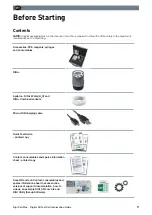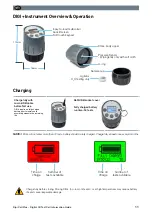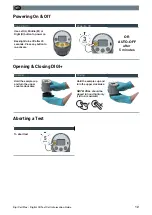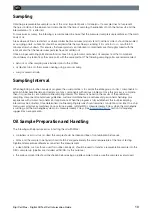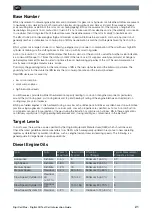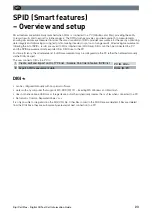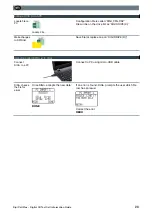
Digi Cell Plus - Digital Oil Test Cell Information Guide
21
GB
Base Number
BN is only relevant to diesel engine lubricants and not relevant for gear oils or hydraulic oils. Alkaline additives are present
to neutralise acids derived from both combustion (mainly strong sulphuric and nitric acids) and those weaker, organic
acids resulting from oxidation of the oil as occurs during ageing. BN is a measurement of the capacity of engine oil for
neutralising strong acids from combustion of fuel oil. It is not a measure of how alkaline an oil is (the alkalinity is more akin
to soapiness than strong alkali) but it instead measures the alkaline reserve of the oil or its ability to neutralise acids.
The BN of trunk piston diesel engines (high and medium speed) will fall due to exposure to combustion products but
generally reaches a stable level as consumption of BN by neutralisation is matched with replenishment by fresh oil top-
up.
BN of system oils in large 2 stroke cross head type engines may rise due to contamination of the oil with very high BN
cylinder oil draining, via the stuffing boxes or from top-up with incorrect oil grades.
A drop of around 50 % of fresh oil BN indicates that the oil is almost at the end of its useful life. Another useful indication
is a minimum BN equal to 7 times the sulphur content of the fuel in use. Oil suppliers usually recommend a change or
partial replacement at this level in order to optimise the acid neutralising properties of the oil. This recommendation is
mostly based on engine manufacturers’ advice.
Put simply, the governing factor for the rate of decay of BN is the fuel sulphur level and the initial sump volume. The
governing factor for the stable final BN level is the oil consumption rate and the fuel sulphur level.
Rapid BN decrease is caused by:
• low oil consumption
• small sump volumes
• high fuel sulphur levels
Low BN reserves provide insufficient neutralisation capacity leading to corrosion of engine components particularly
around the piston ring pack, piston ring lands and top end bearing. Fouling of the engine internals and under piston
cooling ways may also increase.
BN in gas-fuelled engines is often achieved using a very low ash additive pack. Additives are often based on automotive
practice using magnesium in preference to calcium salts. Low ash properties are specified, as hot ash on combustion
components can result in pre-ignition of the gas during the induction or compression strokes. BN in these applications
can fall very rapidly due to high operating temperatures and, if using landfill gas, contaminants in the fuel itself.
Target Levels
In most cases there will be a value specified by the Original Equipment Manufacturer (OEM) which should be used.
Check the latest guidelines and service letters from OEMs which are regularly updated in response to new operating
regimes as determined by market conditions, such as engine load and vessel steaming speeds. The following is a
general guide for target levels in given applications:
Diesel Engine Oils
Type
Fuel
Water %
Maximum
New Oil BN
(Typical)
BN value
(% Change)
Typical Measurement
Frequency in days
Automotive
Distillate
0.5 %
5
Minimum 1 (-60 %)
30
High Speed
Distillate
0.3 %
10
Minimum 2 (-50 %)
14
Medium Speed
Distillate
0.2 %
15
Minimum 5 (-50 %)
7
Medium Speed
Residual
0.2 %
30 to 50
Minimum 10 (-50 %)
7
Slow Speed (Cylinder Oil)
Residual
LS
(< 0.1 %)
-
15 to 40
Minimum 5 (-60 %)
5
Slow Speed (Cylinder Oil) Residual
HS
-
70 to 150
Minimum 20 (-70 %)
3
Slow Speed (System Oil) Residual
0.2 %
5
Increase to 12 (+50 %)
7



